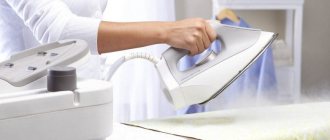Operating principle of the device
The operating principle of a working device is as follows:
- water is poured into a special reservoir;
- Due to the valve device, water from the reservoir enters the soleplate of the iron and turns into steam.
Important! It is necessary to use distilled water for the device to prevent scale from appearing. Boiled water should also not be used, as it contains a large amount of salts.
Using the valve, you can regulate the amount and speed of flow. This publication will tell you which steam generator to choose for ironing and cleaning.
Has your steam generator broken down?
Not really
Why is steam generator failure dangerous?
If the steam generator breaks down and starts spitting, the following problems may occur:
- Instead of steaming, the device begins to wet things. A puddle of water may form, which is dangerous when using electrical appliances.
- The item will be poorly steamed and wet. In this case, when it dries, it will become wrinkled again. An unpleasant odor and mold may also develop.
- Droplets of water, possibly rusty, will get on your clothes. They will cause stains.
Important! If water begins to leak from the equipment, then immediately disconnect it from the network. Then you need to determine the cause of the failure.
How does the steam supply work?
The steam supply in the steam generator is arranged as follows:
- The water in the tank is heated to such a temperature that it turns into steam.
- Hot dry steam flows through the tube.
- When you press a button on the handle, steam comes out of the holes in the sole.
After water is poured into the tank, it is necessary for time to pass - from 2 to 10 minutes. It depends on the steam generator model.
Read how to use the Tefal steam generator here.
How does the steam supply work in an iron?
The steam supply mechanism in the devices of all Bosch, Tefal and others is the same.
- Cold water is poured into the reservoir, which is located on the body just above the sole.
- Set the desired heating temperature for the soleplate of the iron.
- The steam supply mode is activated, and a small portion of water enters a special chamber with a heating element, where the liquid is converted into steam.
- After pressing the button located on the handle of the iron, which turns on the steaming mode, pressure is created in the chamber, and hot moist air is supplied to the fabric through the holes.
Main causes of failure
There are several reasons why a steam generator can fail and start spraying water. There are only three main reasons. Below they are discussed in more detail.
Broken valve
To make sure that the cause of the breakdown lies in a valve malfunction, you must do the following:
- Close the valve.
- Turn on the device in any mode.
- Start swinging the iron in different directions.
If drops of water appear, you need to make sure that access to moisture is not blocked. The solution to the problem in this case is to replace the valve.
Incorrect operation
If the soleplate of the iron does not reach the set temperature, steam cannot be supplied. Otherwise, water may escape from the device.
Important! Before you start ironing, you need to set the required temperature and select the type of fabric. Then you need to wait until the indicator turns off.
Only when the device is completely heated and the indicator turns off can you begin the steam release process. Before the iron heats up, it must be kept in an upright position.
Once fully heated, the indicator will turn off immediately. Otherwise, instead of steam, water will come out of the device used. The filler cap should always be tightly closed until it clicks. Otherwise, the water will ruin your clothes.
Careless kinking of the hose
Water along with steam will be released in any case, even if the hose is slightly pinched or the iron is located opposite the steam outlet, or the hose is much lower. Water, in this case, will begin to come out within a few minutes, this leads to a traffic jam. Because of this, water cannot enter the device being used.
Attention! Water circulation is disrupted and steam condensate is formed. Steam cannot pass through the holes without taking with it a stream of water. When there is a lot of water in the plug, it is possible for water to flow back into the niche and moisture collection container.
How to disassemble and repair it yourself?
If the reason for the breakdown of the Philips steam generator is not related to trivial faults such as an abundance of scale or damage to the electrical cord, then you need to look for it inside the device.
Often the device stops working due to a breakdown of the electromagnetic coil. You can check its performance using a multimeter.
Trying to get inside the device is only possible if you have some knowledge in the field of electronics.
Step-by-step instructions for disassembling a Philips steam generator:
- Disconnect the device from the network.
- Remove the protective rubber bands from the steam station and unscrew the bolts that are located under it.
- Remove the top cover. Below it is the upper case, which is held on by 3 screws. They also need to be unscrewed.
- Removing the housing, you can see the electromagnetic coil, which needs to be replaced. It is held on by one nut.
- After replacing the part, the device must be reassembled in the reverse order.
Does not supply steam: what is the cause of the malfunction and what to do?
If after turning on the device it does not supply steam, you can try to deal with the problem on your own. Possible reasons leading to the malfunction:
- The device is clogged with scale. To get rid of it, you need to clean it. Most models produced under the Philips brand are equipped with an automatic function for getting rid of lime deposits. To do this, pour water into the device, turn it on and press the desired button. After a few hours, the liquid is drained, washing the boiler again. Some models require cartridge replacement.
- The button responsible for supplying steam is not pressed. To deal with the problem, you need to press and hold it until the device starts working.
- The appliance is not warm enough. As a rule, steam is supplied 2 minutes after turning on the equipment.
- There is too little water in the boiler. To start steam supply, you just need to top it up to the MAX mark.
Steam will not be supplied when the device is stationary or placed on weight and at an angle with the automatic steam supply mode turned off. For the device to start functioning, it must be moved to the working position.
Doesn't turn on
If your Philips steam generator does not turn on, the reasons may be the following:
- The power cord is damaged. When there are no visible defects, it is difficult to determine the broken area. Need help from a specialist.
- There is no power in the network. To check the serviceability of the outlet, you need to plug in any other device.
- The power indicator does not work. In this case, the device itself may be working properly. You need to press the steam button to check its functionality.
- There was an electronics malfunction. In this case, the help of a specialist is required.
When troubleshooting, you need to refer to the instructions that came with the device. It lists the main reasons that can lead to incorrect operation of a particular model.
Water is leaking from the device
If water is leaking from your Philips steam generator, the reasons may be:
- There is a lot of condensation in the steam hose. This can happen after the device has been idle for a long time. To solve the problem, you need to point the sole of the iron to the side and hold the steam button until the water stops flowing. You also need to check the hose for kinks and clamps.
- The appliance has been filled with water containing aromatic additives or other contaminants. To cope with the problem, the boiler needs to be flushed. Then clean water is poured into it and the device is started again.
- The steam boost function was used too often. You can continue to use the appliance, but wait a little while before pressing the high steam button again.
- After descaling the appliance, water remains in it. This is what flows out of the sole. You just need to wipe it with a cloth.
- The shutter valve is broken. It needs to be replaced.
- The holes are clogged with scale. To get rid of the problem, cleaning is necessary.
Rusty water splashes
- Water containing impurities was poured into the device. To get rid of the problem, the boiler needs to be flushed.
- The device had not been used for a long time, but there was some water left in it. To solve the problem, the tank must be thoroughly rinsed.
- The heating element has failed. It needs to be replaced.
If flushing the boiler does not help solve the problem, you should contact a service center.
What should I do if water is leaking from the steam generator?
To fix the problem, you need to install an iron with a hose above the steamer. After about 15 seconds, the water will rise and the plug will collapse. If there is a lot of moisture in the plug, you must first wait for the device to cool down. Next, the hose is disconnected from the device. It is located above the sink. The water is drained from the iron.
It is possible that to eliminate the cause of water leakage, descaling of the device is required. To do this, you need to pour in a special product or a folk remedy to remove plaque. Next, the device turns on at maximum temperature. Then the water is drained and the procedure is repeated again.
The water will touch the hot heating element. The contact of cold and hot, as well as the impact of the product, will allow the scale to lag behind the walls and exit through the holes in the sole.
Advice! Some models of steam generators have a special rod for collecting scale. It needs to be cleaned periodically.
To do this, place it in a solution with citric acid for several hours. The rod is then reinserted into the device. After cleaning, ironing must be done on unnecessary scraps of fabric, as scale will come out. If after cleaning the problem is not solved, then you need to contact a specialist.
If the valve breaks, you can try cleaning the nipples at home. To do this you need:
- Mix one part citric acid with five parts water.
- Pour the resulting mixture into the tank.
- Turn on the iron.
- After the soleplate has heated up, you need to press the steam button.
If the above steps do not help, the device must be taken to a service center. You should not repair the nipples yourself. If the leakage is due to improper use, then there is no need to take the steam generator to a service center. It is only important to start using it correctly.
Do you regularly descale your steam generator?
Not really
Valve failure
After water enters the tank, it flows to the heated sole from the inside. To regulate the amount of liquid released, respectively, and steam, a valve is built in. Its operation is controlled by the user by pressing the steam button.
The valve structure contains rubber gaskets; they are subject to rapid wear. High temperatures negatively affect rubber, reducing its performance properties and leading to valve leaks. As a result, instead of steam, water appears in the holes.
Important! It will be difficult to repair the nipples yourself; it is recommended to take the device to a service center. Rubber gaskets cannot be replaced, but new valves can be installed
An easy way to fix the problem at home is to wash the nipples:
- make a solution of citric acid: 1 part of the substance to 5 parts of water;
- pour liquid into the reservoir and turn on the iron;
- After heating the sole, activate the steaming mode.
The acid removes metal deposits, helping to restore normal valve function.
Leak prevention
In order for the steam generator to operate without problems for a longer time, it is necessary to follow a number of rules:
- The frequency of steam use should be reduced. Enable this mode only when really necessary. The more this function is used, the faster the device parts wear out.
- After ironing, the remaining liquid must be drained.
If you follow these simple rules, you can significantly reduce the likelihood of breakdowns and save on repairs.
Important! If the breakdown is not complicated, then you can repair the device yourself. The most common cause of failure is scale buildup. Therefore, the device must be cleaned on a regular basis.
There are several ways to clean a steam generator - using folk or industrial products. Some devices also include a special cleaning rod. It also needs to be cleaned periodically. You can find out how to clean a Tefal steam generator from scale here, and Philips here.











